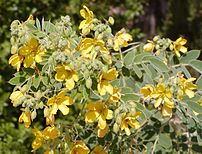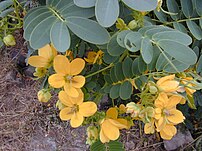Senna
| Senna subsp. var. | ||||||||||||||||||||||||||||||||||||||||||||||||||||||||
|---|---|---|---|---|---|---|---|---|---|---|---|---|---|---|---|---|---|---|---|---|---|---|---|---|---|---|---|---|---|---|---|---|---|---|---|---|---|---|---|---|---|---|---|---|---|---|---|---|---|---|---|---|---|---|---|---|

|
|
| ||||||||||||||||||||||||||||||||||||||||||||||||||||||
| ||||||||||||||||||||||||||||||||||||||||||||||||||||||||
Senna (from Arabic sanā), the sennas, is a large genus of flowering plants in the family Fabaceae, subfamily Caesalpinioideae. This diverse genus is native throughout the tropics, with a small number of species reaching into temperate regions. The number of species is usually estimated to be about 260, [1] but some authors believe that there are as many as 350. [2] The type species for the genus is Senna alexandrina. About 50 species of Senna are known in cultivation. [3]
Senna species make good ornamental plants and are used for landscape gardening. The wide variety of species and ecological adaptations makes at least a handful of sennas suitable for any climate warmer than cool-temperate.
The following description is rather cursory and based mostly on Irwin and Barneby (1982), [4] but partly on Marazzi (2006) [1].
The sennas are typically shrubs or subshrubs, some becoming scandent when growing into other vegetation. Some are herbs or small trees. Many species have extrafloral nectaries.
The leaves are paripinnately compound, the leaflets opposite. The inflorescence is a raceme, or some arrangement or racemes. The pedicels lack bracteoles.
The flowers produce no nectar. They are buzz pollinated and offer pollen as a reward to pollinators. They are often asymmetric. The petals are 5 in number, similar to each other, yellow, or rarely white.
The stamens may be as few as 4, but usually there are 10. When 10, they occur in 3 sets. The 3 adaxial stamens are staminodial. The 4 medial stamens are smaller than the 3 abaxial stamens. The anthers are basifixed and open by two terminal pores or short slits.
The gynoecium is often enantiostylous; that is, it is deflected laterally to the right or left. This makes the flower asymmetric, but the perianth and the androecium may be asymmetrical as well.
The fruit is a legume, indehiscent or tardily dehiscent.
Cultivation
Propagation
Pests and diseases
Species
Selected species:


- Senna acclinis (F.Muell.) Randell Template:Verify source
- Senna aculeata (Benth.) H.S.Irwin & Barneby
- Senna alata (L.) Roxb. – Candle Bush, Candelabra Bush, Empress Candle Plant, Candlestick Tree, Ringworm Tree, "candletree"
- Senna alexandrina Mill. – Alexandrian Senna, Egyptian Senna, Tinnevelly Senna, East Indian Senna, sene de la palthe (French)
- Senna angulata (Vogel) H.S.Irwin & Barneby
- Senna appendiculata (Vogel) Wiersema (= S. australis)
- Senna armata (S.Watson) H.S.Irwin & Barneby
- Senna artemisioides (Gaudich. ex DC.) Randell – Silver Senna, Feathery Senna
- Senna auriculata (L.) Roxb. – Avaram Senna, avaram, ranawara
- Senna aversiflora (Herbert) H.S.Irwin & Barneby
- Senna bicapsularis – Rambling Senna, Christmas Bush, Money Bush, Yellow Candlewood
- Senna birostris (Vogel) H.S.Irwin & Barneby
- Senna candolleana (Vogel) H.S.Irwin & Barneby
- Senna cardiosperma (F.Muell.) RandellTemplate:Verify source
- Senna caudata (Standl.) H.S.Irwin & Barneby (Costa Rica, Panama)
- Senna cobanensis (Britton & Rose) H.S.Irwin & Barneby
- Senna corymbosa – Argentine Senna, Argentina Senna, Buttercup Bush, Flowering Senna, (Texas) Flowery Senna, Tree Senna
- Senna covesii (A.Gray) H.S.Irwin & Barneby – Desert Senna, Coues' Senna, Rattleweed
- Senna cumingii (Hook. & Arn.) H.S.Irwin & Barneby
- Senna cuthbertsonii (F.Muell.) RandellTemplate:Verify source
- Senna didymobotrya (Fresen.) H.S.Irwin & Barneby
- Senna domingensis (Spreng.) H.S.Irwin & Barneby (Cuba, Hispaniola)
- Senna excelsa (Schrad) Irwin & BarnebyTemplate:Verify source
- Senna fruticosa (Mill.) H.S.Irwin & Barneby
- Senna garrettiana (Craib) H.S.Irwin & Barneby
- Senna gaudichaudii (Hook. & Arn.) H.S.Irwin & Barneby – Heuhiuhi (Pacific Islands, Queensland)[5]
- Senna hayesiana (Britton & Rose) H.S.Irwin & Barneby
- Senna hebecarpa – American Senna, Wild Senna
- Senna helmsiiTemplate:Verify source
- Senna heptanthera (F.Muell.) RandellTemplate:Verify source
- Senna hirsuta (L.) H.S.Irwin & Barneby
- Senna hirsuta var. puberula
- Senna italica Mill.
- Senna italica ssp. italica – Neutral Henna
- Senna ligustrina (L.) H.S.Irwin & Barneby
- Senna lindheimeriana (Scheele) H.S.Irwin & Barneby – Velvet-leaved Senna
- Senna macranthera (Collad.) H.S.Irwin & Barneby
- Senna macranthera var. macranthera
- Senna magnifolia (F.Muell.) RandellTemplate:Verify source
- Senna marilandica (L.) Link
- Senna martiana (Benth.) H.S.Irwin & Barneby
- Senna martiana (Schrad) Irwin & BarnebyTemplate:Verify source
- Senna multiglandulosa (Jacq.) H.S.Irwin & Barneby
- Senna multijuga (Rich.) H.S.Irwin & Barneby
- Senna nicaraguensis (Benth.) H.S.Irwin & Barneby
- Senna nitida (Rich.) H.S. Irwin & Barneby
- Senna notabilis (F.Muell.) RandellTemplate:Verify source
- Senna obtusifolia (L.) H.S.Irwin & Barneby – Chinese Senna, Sicklepod, Foetid Senna, Sickle Senna, Coffeeweed, Arsenic Weed, "blunt-leaved senna", "coffee pod", "java bean"
- Senna occidentalis (L.) Link – Coffee Senna, Mogdad Coffee (Pantropical)[6]
- Senna odorata (R. Morris) Randall
- Senna oligoclada (F.Muell.) RandellTemplate:Verify source
- Senna oligophyllaTemplate:Verify source
- Senna pallida (Vahl) H.S.Irwin & Barneby
- Senna papillosa (Britton & Rose) H.S.Irwin & Barneby
- Senna pendula (Willd.) H.S.Irwin & Barneby
- Senna pendula var. stahlii (Urb.) Irwin & Barneby
- Senna pleurocarpa (F.Muell.) RandellTemplate:Verify source
- Senna polyphylla (Jacq.) H.S. Irwin & Barneby
- Senna purpusii (Brandegee) H.S.Irwin & Barneby
- Senna reticulata Willd[7]
- Senna rugosa (G.Don.) H.S.Irwin & Barneby
- Senna scandens
- Senna septemtrionalis (Viv.) H.S.Irwin & Barneby
- Senna siamea (Lam.) H.S.Irwin & Barneby – Siamese Senna, khi-lek (Thai)
- Senna spectabilis (DC.) Irwin & Barneby
- Senna spectabilis var. excelsa
- Senna spectabilis var. micans - sometimes placed in Senna macranthera
- Senna splendida (Vogel) H.S.Irwin & Barneby
- Senna surattensis (Burm.f.) H.S.Irwin & Barneby (= S. speciosa Roxb.)
- Senna sulfurea (Collad.) H.S.Irwin & Barneby
- Senna sylvestris (Vell.) H.S.Irwin & BarnebyTemplate:Verify source
- Senna timoriensis (DC.) H.S.Irwin & Barneby
- Senna tora L. – Sickle Wild Sensitive-plant
- Senna trolliiflora
- Senna undulata (Vahl) H.S.Irwin & Barneby
- Senna venusta (F.Muell.) RandellTemplate:Verify source
- Senna wislizeni – Wislizenus' Senna, Shrubby Senna
Gallery
References
- ↑ 1.0 1.1 Phylogenetic relationships within Senna (Leguminosae, Cassiinae) based on three chloroplast DNA regions: patterns in the evolution of floral symmetry and extrafloral nectaries, 2006, Brigitte Marazzi, Peter K. Endress, Luciano Paganucci de Queiroz, and Elena Conti, American Journal of Botany, volume 93, issue 2, pages 288–303
- ↑ Barbara R. Randell and Bryan A. Barlow. 1998. "Senna" pages 89-138. In: Alexander S. George (executive editor). Flora of Australia volume 12. Australian Government Publishing Service: Canberra, Australia.
- ↑ Anthony Huxley, Mark Griffiths, and Margot Levy (1992). The New Royal Horticultural Society Dictionary of Gardening. The Macmillan Press,Limited: London. The Stockton Press: New York. ISBN 978-0-333-47494-5 (set).
- ↑ Howard S. Irwin and Rupert C. Barneby. 1982. "The American Cassiinae: A synoptical revision of Leguminosae tribe Cassieae subtribe Cassiinae in the New World". Memoirs of the New York Botanical Garden 35.
- ↑ \http://www2.bishopmuseum.org/ethnobotanydb/resultsdetailed.asp?search=kolomona
- ↑ http://www.ars-grin.gov/cgi-bin/npgs/html/taxon.pl?100059
- ↑ SANTOS, Rogério Nunes dos; SILVA, Maria Goretti de Vasconcelos, and BRAZ FILHO, Raimundo (2008). Constituintes químicos do caule de Senna reticulata Willd. (Leguminoseae) ("Chemical constituents isolated from the wood of Senna reticulata Willd") Química Nova [online], volume 31 issue 8, pages 1979--1981 (in Portuguese). Template:Doi "It is the first report of 1,3,8-trihydroxyanthraquinone and 3-methoxy-1,6,8-trihydroxyanthraquinone in higher plants."





